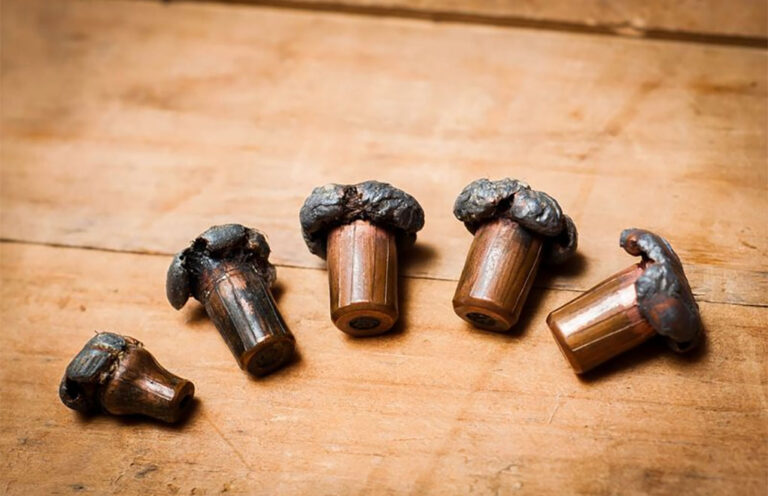
This excerpt from The Ballistics Handbook provides a general overview and history of terminal ballistics.
That little blob of metal, so content in its metallic case, has been sent screaming down the barrel, spinning until it’s dizzier than a 2-year-old on sugar, sailing through the air faster than, well I was going to say a speeding bullet, but, it’s going pretty damned fast. Then, instantly, violently, the journey ends. At the gun range it just rips paper and meets its untimely demise in a sand bank or dirt berm. Perhaps it smashed through hide, bone and vital tissue, putting dinner on the table for a family all winter. Or maybe it was built like a race car and got to fly long and high, only to end in the sweet ringing of steel. Best of all, that bullet may have saved someone’s life. Whatever the case, the end of a bullet’s life is an important part of our study, or what we call terminal ballistics—what happens when it makes impact.

Whether in a defensive situation or on a dangerous game hunt, there are times when the construction and terminal performance of a bullet means life or death. In the case of hunting bullets, you want a quick, humane kill—after all, the bullet’s job is to reach the vital organs to destroy tissue. No matter how many trajectory charts you’ve memorized, no matter how many lines-per-inch the checkering on your AAA Circassian walnut features, it is the bullet, and only the bullet, that touches a game animal and delivers the death blow.
At this stage of the game you’ve managed to place the shot where it belongs, and now you need to consider what’s going to happen after impact. Will the bullet penetrate sufficiently? Will it expand properly? Was it of suitable construction to handle the task at hand? Did you choose the proper type of bullet to meet the requirements you need? All these questions and more fall under the heading of terminal ballistics.
In this section, the handgun will receive much more attention than it has previously. While the exterior ballistics of handgun bullets aren’t nearly as complex as that of rifles, the terminal ballistics of a handgun are very interesting. Handgun hunting bullets have come an awful long way, and there are some absolutely incredible personal defense choices out there, too. Their performance needs to be analyzed to best choose a handgun caliber, as well as settle some old arguments.
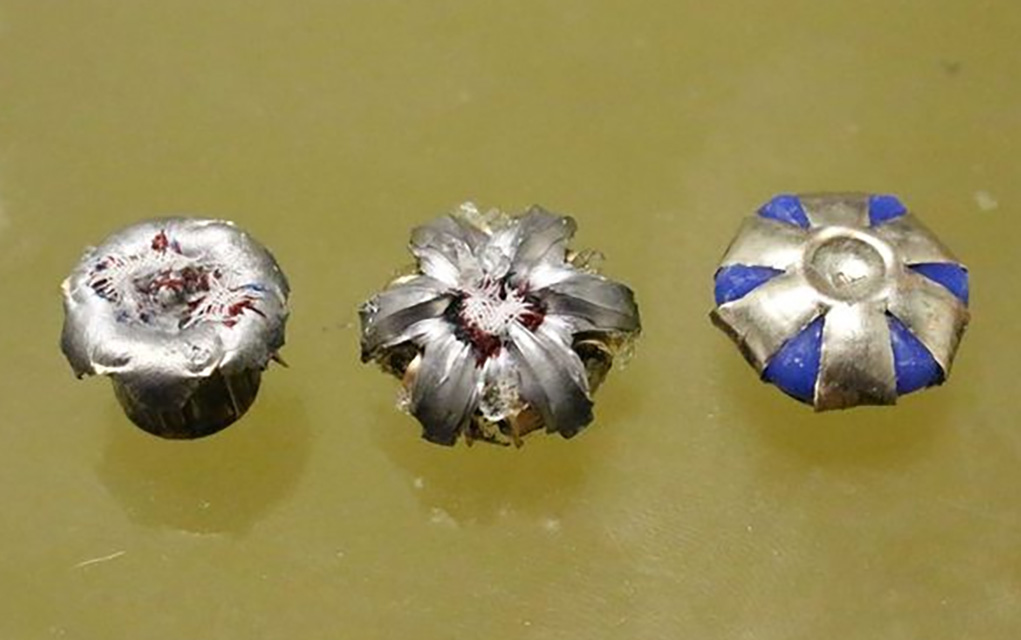
Rifle bullets have changed for the better as well, having many new designs available. Some of these designs are a far cry from the cup-and-core bullet of our grandfathers’ era and deliver some outstanding performance, almost forcing us to rethink the old cartridge and caliber recommendations. These innovations implore you to take a new look at how much cartridge/bullet is really needed to get the job done. I am always intrigued about new bullet designs, and I’ve had the opportunity to test some of these around the globe on animals small, medium and large.
There is much demand placed upon the rifle bullets of today. You expect your modern rifle bullet to be a death-ray. If you do our part in holding the rifle on the right spot and squeeze the trigger properly, you expect instantaneous results. The bullet needs to be accurate, retain almost all of its energy downrange, expand well enough to create a huge wound channel, and penetrate deep enough to destroy the vitals from any angle. Oh, and you want it cheap, too! No worries!
Well, the bullets of today can meet most of those parameters, but not all. There are some that will certainly deliver the goods, but the materials and manufacturing costs are higher than the bullets of yesteryear. While some of the tried-and-true hardcast lead and cup-and-core bullets still perform wonderfully in certain situations, there are those times when the cost of a hunt or the scarcity of a coveted tag warrant the investment in the best projectile money can buy, no matter which of the attributes listed above is most important.
The birth of the premium bullet industry hearkens back to 1948 in Canada, when John Nosler experienced terrible bullet failure while trying to relieve a large-bodied moose of its life with a .300 Holland & Holland Magnum. The cup-and-core bullets that Nosler was using simply weren’t strong enough to handle the high impact velocity of the Super .30 and had prematurely expanded on the moose’s shoulder, giving poor penetration. His idea of a dual-core bullet separated by a copper partition really set the hunting world on its ear and created an entire market for premium projectiles. Fast-forward to the 21st century, and you have monometal bullet designs that would certainly make my grandfather cock an eyebrow. Some of these newcomers use a funky sort of nipple at the front end to cause trauma via a cavitation bubble, delivering straight-line penetration and a cylindrical core of trauma. Some designs, like the aforementioned Nosler Partition, have been with us for decades and have their devout followers.
Whatever the case, there is now a proper tool for the job at hand. You, as the hunter, shooter and consumer, need to be honest with yourself about the requirements of your shooting situation to choose a bullet that will give you the results you’re after. We will start the study of terminal ballistics by dealing with a bit of bullet history and how bullet performance so heavily influenced the reputation of the cartridges themselves. We’ll then examine how the projectiles of the 21st century could and should change the way we think about cartridge requirements.
The History of Terminal Ballistics
The first projectiles for the firearm were round lead balls, slightly smaller than bore diameter, to be “patched” for a tight seal. Lead was the chosen material, not for its durability upon impact, but for its malleability in forming the projectiles. Lead is easy to work and shape, melts at a relatively low temperature and is plentiful. This was perfect for the early users of the cartridge guns, as many firearms were sold with a set of molds of appropriate caliber and bullet weight for that firearm. Think of the buffalo hunters on the Great Plains, hunting all day and sitting by their campfire at night, melting lead and casting their own lead bullets for the next hunt. However, lead has several shortcomings, especially with modern firearms and propellants.
Your goal as a hunter (we’ll get to the self-defense bullets soon enough), is to deliver a quick, humane kill to minimize the suffering of the game animal. For most of your hunting, with the exception of solid bullets or a shot column from a shotgun, you depend on the bullet to create massive hemorrhaging by destroying as much vital tissue as possible. The expansion of a bullet—if it is designed to expand—creates hydraulic shock, which destroys tissue as well. Now, when a material as soft as lead impacts hide, bone and water-rich flesh at an appreciable velocity, you can have very rapid expansion. Your projectile will certainly meet enough resistance to flatten a round ball or rapidly deform the meplat of a lead bullet. So the lead ball or bullet must be of sufficient weight and diameter to properly penetrate into an animal’s vitals in order to guarantee a quick kill, and the velocity must be kept to a reasonable level, say below 2,200 fps. Even then, the bullet can exhibit penetration problems if the shot is too close.
The stories of Frederick Courteney Selous from the late 19th century are illuminating. Selous would hunt elephants with a muzzleloading four-bore rifle stoked with a lead ball weighing 1/4 pound, propelled by over 500 grains of blackpowder. That gives you an idea of how the early projectile directly affected the choice of bore diameter; you simply needed to compensate for a lack of penetration with sheer mass.
At moderate velocity typical of the .30-30 Winchester or .45-70 Government, or most of the classic handgun cartridges like the .38 Special and .45 Colt, a lead projectile will work well, giving a good blend of expansion and penetration. Many of these cartridges are still loaded with lead projectiles today, and they perform superbly. For some of the faster cartridges like the .44 Magnum, lead bullets can be hardened by adding a specific amount of antimony to the molten lead while casting, resulting in a harder alloy and better terminal ballistics.
In light of the velocity increases that smokeless powder brought to the table, there needed to be an advance in the construction of projectiles. It was Lt. Col. Eduard Rubin of Switzerland who, in 1882, had the ingenious idea of jacketing the lead bullets in a layer of copper—a metal hard enough to avoid the issues associated with heavy lead deposits in the barrel, yet soft enough to work perfectly with the steel rifling of the barrel. Rubin completely covered the spitzer projectile, leaving no exposed lead, creating the first “full metal jacket” or FMJ as we all know it today.
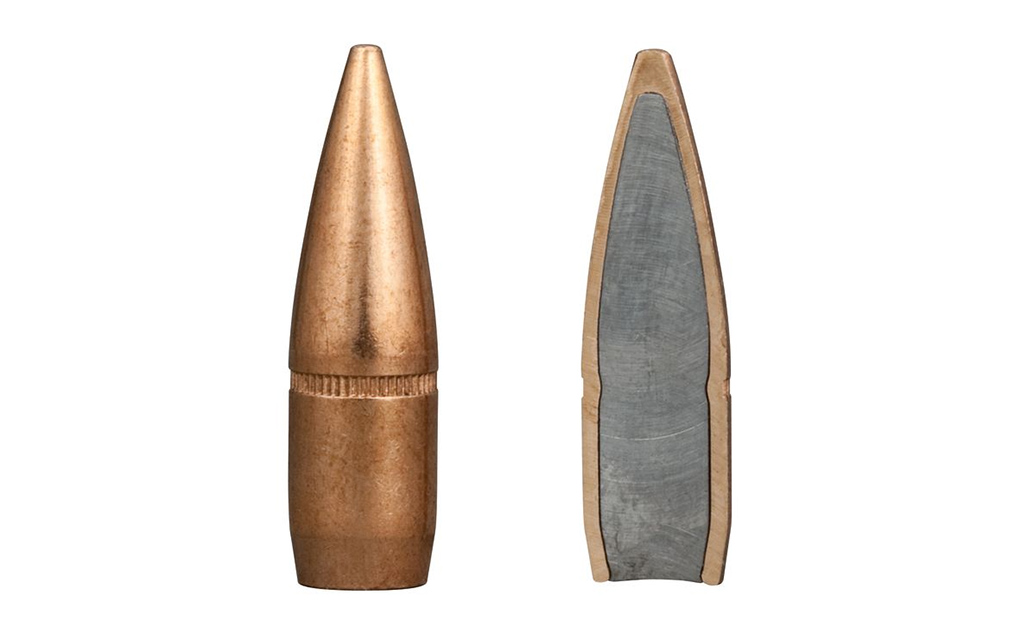
The lead bullets that had previously been used in combat had such a terrible effect on soldier’s bodies. Think about the photos and accounts from the Civil War and how some of those large-caliber lead bullets and balls would not only inflict horrible flesh wounds, but would sometimes tear limbs off at the bone. The advent of the FMJ made total sense as a weapon of war. Indeed, many countries of the world felt that the horrific wounds of injured soldiers could be minimized by the use of the non-expanding projectiles. The Hague Convention of 1899, in Declaration III, specifically prohibited the use of any expanding projectiles in international warfare, though many incorrectly attribute this prohibition to the Geneva Convention. For the record, the United States did not agree to the treaty. This decision included so-called Dum-Dum bullets: those FMJs that had any exposed lead, or a cross-slot cut into the nose for expansion. (An interesting note is that Dum-Dum bullets were named after the British military facility near Dum-Dum, West Bengal, India. It was here that Captain Neville Bertie-Clay developed the Dum-Dum bullet, an expanding projectile designed for the .303 British cartridge, with a radical hollowpoint. The expansion of this bullet could be best described as violent, and I can only imagine the devastating result of using this projectile in combat.)
The result of adding a copper jacket to the traditional lead projectile completely changed the hunting world as well. Not only could these new projectiles be driven to much higher velocity and with fantastic accuracy, but by manipulating the amount of exposed lead at the nose, or meplat of the bullet, the amount of expansion could be controlled. This allowed ammunition manufacturers to tune the bullet to the velocity of the cartridge and better control the expansion/penetration ratio. The method of drawing a copper cup around the lead core results in what I have referred to elsewhere in this book as a cup-and-core bullet.
There were failures early on. The copper cup would often separate from the lead core upon impacting a game animal, and penetration was severely affected. Attempts were made to better keep the bullets together during the terminal ballistics phase. Remington’s 1939 Core-Lokt bullet used a cannelure that stepped the copper jacket into the lead core to better keep the bullet in one piece. A tapering copper jacket, thicker toward the rear, made an appreciable difference in controlling—that is, slowing—the amount of expansion so that the necessary penetration could be obtained.
In the first half of the 20th century, hunters pretty much had two choices, especially for the dangerous game of Africa: a soft-point bullet with a bit of exposed lead at the nose with a copper jacket that covered the remainder of the bullet, or a full metal jacket bullet—commonly referred to as a solid—which offered no expansion whatsoever, but would provide fantastic penetration against those animals with extremely thick hides and huge, tough bones. There were volumes of material written about the effectiveness (or lack thereof) of the waves of new cartridges being released by British, German and American ammunition and firearms companies. If you are a fan of firearms and cartridge development (and by picking up this book I would assume you are), there are plenty of articles and books available that give a good glimpse into the situation at various points throughout the first half of the 20th century. People like Elmer Keith, Jack O’Connor, John “Pondoro” Taylor, W.D.M. Bell and John Hunter authored many of these works, and these gentlemen all had huge amounts of hands-on experience with the tools of their day. In reading their works, one can get a definite feel for the opinions they garnered through trial and error, and these opinions are still heralded today.
However, the reader must also appreciate the fact that many of the opinions generated by these now-famous authors were directly influenced by the terminal performance of the projectiles of their era. One of my favorite volumes, written by John “Pondoro” Taylor—an Irishman who tramped all over southern and eastern Africa—is African Rifles and Cartridges, a treatise on firearms and cartridges commonly used throughout the Dark Continent from 1920 until 1948 or thereabouts. Taylor had, according to his own accounts, used the vast majority of popular cartridges, from the .22 Long Rifle up to and including the behemoth .600 Nitro Express. He recounted his experiences with those cartridges on all sorts of African game, from the diminutive antelope up to the gigantic elephant. While few may have the opportunity to hunt Africa, this cross-section of game taken by Taylor includes many that are similar to our North American species.
Jack O’Connor was a fantastic author, known for championing the .270 Winchester, and was a proponent of the lighter calibers using bullets at higher velocities. Elmer Keith, an Idaho rancher with an extensive background in firearms, was responsible for the development of several highly popular handgun cartridges, as well as participating in the development of rifle cartridges that went on to influence future developments. These two gentlemen were both very well respected, yet had diametrically opposed views on what made a suitable hunting cartridge for various species. Keith believed in much heavier bullets than did O’Connor. But I firmly believe that their respective points of view were inarguably based on the terminal performance of the projectiles from their era much more than the potential of the cartridges by which they so strongly swore.
Walter Dalrymple Maitland Bell, a Scotsman whose adventures in early 20th century Africa are heralded to this day, was a proponent of the use of small-bore rifles (the 7x57mm Mauser being the most used) for big game, especially on the 1,000-plus elephants he took in his hunting career. Bell, who was an excellent shot, especially under the pressure of being in close proximity of truly dangerous game, made the claim that his “barrel had never been polluted by a soft-point bullet.” He came to rely solely on full metal jacketed bullets, which had the nose portion strengthened by steel, placed under the layer of copper gilding metal. While I don’t think that any Professional Hunter alive today would recommend or even accept the 7x57mm Mauser as an appropriate dangerous game cartridge, Bell was not a hunting client in today’s sense. He had no legal requirements regarding rifle caliber and was literally in uncharted waters with respect to ballistic boundaries. Bell found that 173 grains of bullet properly placed would work just as effectively as 500 grains. If either bullet were placed incorrectly, Bell contended, they were equally ineffective. We can agree that a cartridge as small as the 7mm Mauser is not the best choice for dangerous game, but Bell’s point was that a bullet, if properly constructed, could amaze a hunter as to its actual capabilities. In a very short period of time, the four-bore lead cannonball weighing in at 1/4 pound had effectively been matched with a 173-grain steel and copper jacketed 7mm slug. The terminal ballistics experimentation of Bell (who also used a 6.5x54mm Mannlicher-Schoenaur and a .318 Westley Richards) gave quite a bit of insight into the importance of bullet construction and its correlation to terminal ballistics.
All of these hunters had an irrefutable effect on the reputations of our favorite cartridges on both ends of the spectrum. And many of those endorsements, based on the projectiles available to them at the time, carry on to this day. Today, however, some of these viewpoints need to be revised.
The cup-and-core bullets of the first half of the 20th century were tweaked in many different ways to achieve the consummate blend of expansion and penetration. The Remington Bronze Point was an early release that used a hollowpoint design, capped with a sharp, bronze tip that would not only prevent the meplat of the bullet from being battered under recoil, but would act as a wedge to initiate expansion. It was met with mixed reviews. Some hunters found it to work wonderfully, giving great expansion and hydraulic shock. Others reported that the bullet failed to give any expansion at all—acting just like a solid and giving caliber-size entry and exit wounds. Most folks just used the standard cup-and-core bullets, with varying levels of satisfaction.
All that changed in 1948 when John Nosler went moose hunting. His chosen rifle (and a fine one at that) was the .300 Holland & Holland Magnum, a perfect choice for the distances at which moose may be taken, and a caliber with an excellent reputation for big game. I’m not sure which brand of projectile Nosler was using, but the story as I’ve heard it goes as follows. Nosler had a moose at relatively close range, and while he placed his shots well, right on the beast’s shoulder, the bullets just wouldn’t penetrate. His cup-and-core bullets, driven to a muzzle velocity of just over 3,000 fps, simply were breaking up on the tough muscles and shoulder bones of the huge moose. This left him perplexed. He knew he had done his part, and that there must be a better solution to the problem of bullet construction. Once he got home, he put on his thinking cap and came up with an idea: a bullet divided in two, separated by a partition of copper, which would be made integral with the copper jacket. He took a copper rod of proper dimension, drilled out either end, inserted a lead core and fashioned the front portion into a spitzer profile. The idea was to allow the front portion of the bullet to expand for the tissue destruction necessary for a quick kill, yet keep the rear portion intact for deep penetration. The idea worked perfectly, and the Nosler Partition was born. It did exactly what Nosler intended, giving nearly the penetration of a solid, yet the front expanded properly. Naturally, the performance of this bullet caused it to catch on quickly, and to this day the Nosler Partition remains a favorite of hunters around the globe.
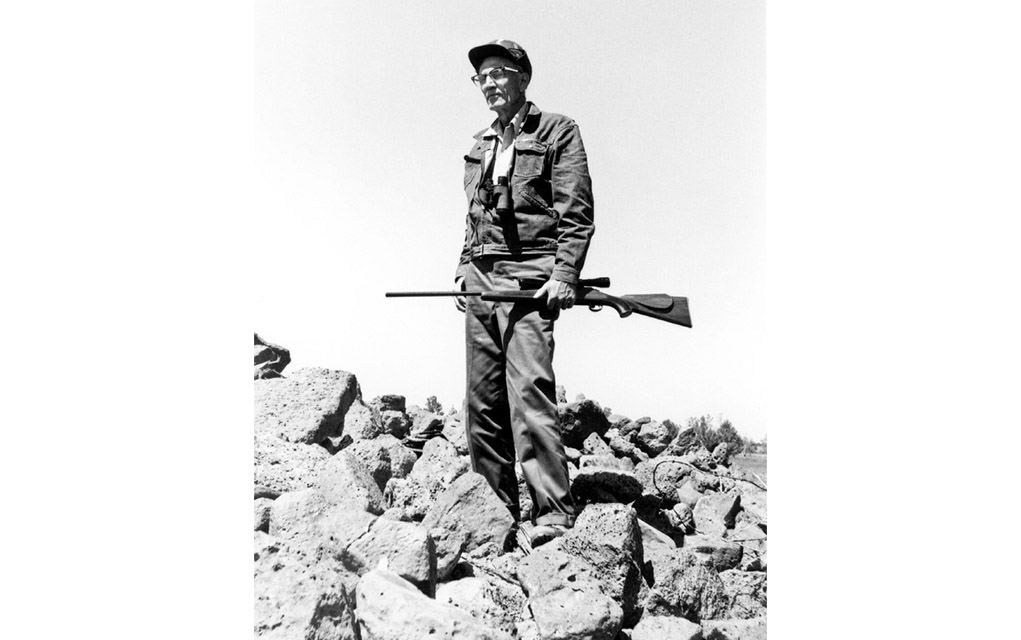
What John Nosler really did was single-handedly kick-start what would become the premium bullet industry. The premium bullet designs that have come onto the market have been nothing short of amazing. In the post-WWII years, many premium or boutique bullet companies popped up, once the raw materials became available once again. There were huge surpluses of powder, and some eager entrepreneurs began to show their wares, resulting in what are household names today: Joyce Hornady, Vernon Speer, Sierra Bullet Company, just to name a few. They gave us the projectiles that, while of standard construction, allowed hunters to develop their own handloaded ammunition with reliable and predictable results. Over the decades, these companies would hone their crafts and continue to push the boundaries of bullet technology.
The Barnes Bullet company dates back to the 1930s, when Fred Barnes was making his own custom bullets in his basement. He sold the company three decades later and, following a succession of sales, the company ended up in the hands of Randy and Coni Brooks. The Brooks’ kept Barnes on for a bit as a consultant, but it was they who had the revolutionary idea. Randy Brooks had experienced bullet failure in the past, and while he was sitting on a high perch in Alaska glassing for spring brown bear and thoughts wandering, he had an epiphany. As he explained it to me, he thought, why not take out the lead. The result: He had designed the all-copper expanding X-Bullet, which solved the problem of jacket/core separation, and led to an entire school of thought known as the monometal expanding bullet. This was a huge development in terminal ballistics. The scored hollowpoint would open upon impact to form an X. The retained weight of the bullet was unprecedented. Brooks also developed a monometal solid for the African heavyweights that remains one of the best on the market even today.
Swift Bullets, hailing from Kansas, has also set an impressive benchmark in the terminal ballistics world. Improving, if you will, on the partitioned bullet design, Bill Hober’s company uses a thicker jacket for their A-Frame bullet, as well as chemically bonding the jacket to the front lead core, further slowing expansion. The A-Frame is a great choice for thick-skinned animals and is ideal for any critter smaller than elephant. When recovered from game animals, it proves to hold its weight very well—often in the 90 to 95 percent range—and shows good expansion on the front end, displaying the classic A-Frame rivet just behind the partition. I’ve often described the Swift A-Frame as “meat-resistant,” meaning the more meat you hit, the greater the resistance to the bullet, the more the A-Frame will expand. On big game, such as bison and Cape buffalo, it will expand to around twice its caliber, yet on smaller game that number diminishes, often whistling clear through … still killing, yet not leaving you with a whole bunch of bloodshot meat. I especially like this bullet when using a big-bore rifle, say a .375 or one of the .40 calibers, for hunting plains game in a dangerous game block, or when chasing elk or moose in an area known to be inhabited by grizzly. Swift makes this bullet not just for the bolt-action rifles (in a semi-spitzer design), but in a flat meplat designed for use in the popular lever-action cartridges, as well as for the hunting revolver cartridges. Were I to choose just one bullet for all of my hunting beside the elephant, it would be the Swift A-Frame. I’ve used it on dozens of different species, and its terminal ballistics make it my personal favorite, even though I know I’m giving up a little bit of ballistic coefficient.
There are now many different bullet designs on the market that feature a sharp polymer tip, serving to act much like the Remington Bronze Tip I discussed earlier. The polymer tip of the bullet is designed to increase the ballistic coefficient, yet upon impact the tip acts like a wedge, initiating expansion. The polymer tip has been incorporated into many different bullet designs: The Barnes TTSX, the all-copper hollowpoint with a tip to promote expansion; the Swift Scirocco II, a heavy jacketed boattail bullet with a bonded core; and the Hornady SST, a standard cup-and-core design. Nosler alone has three tipped models, the Ballistic Tip, AccuBond and E-Tip, and all three are constructed differently.
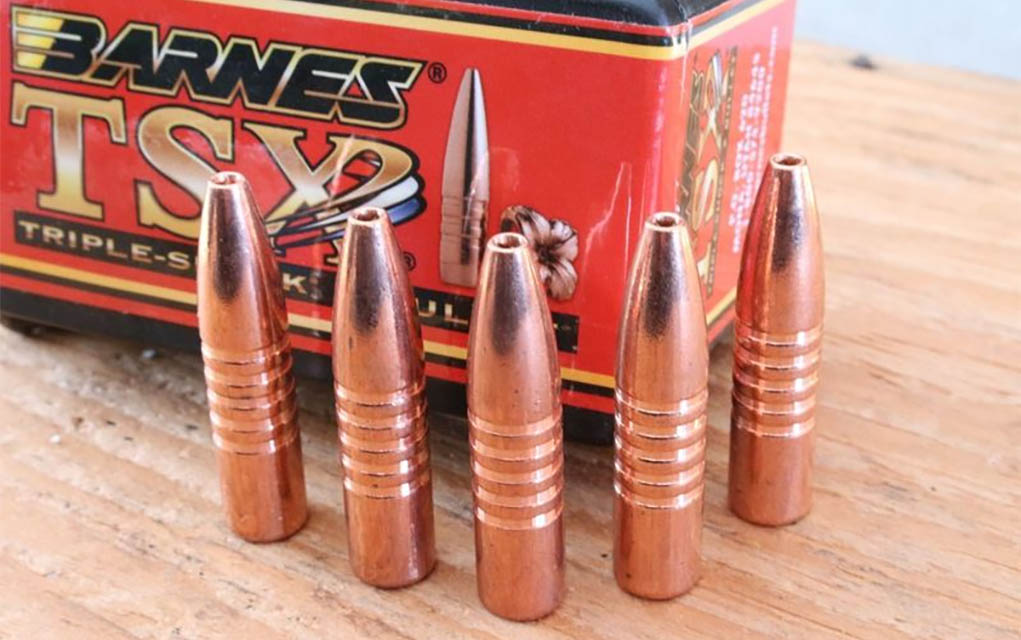
There are specially designed varmint bullets engineered to give an almost explosive terminal performance. These feature very thin jackets and soft lead cores, and are as frangible as can be, delivering all sorts of hydraulic shock. Some are hollowpoints, while others are polymer tipped, but all have come a long way toward their specific goal: creating the red mist that varmint hunters are after.
Lastly, the most recent developments in big game rifle bullet technology are some real eye openers. The Woodleigh Bullet Company of Australia has released their Hydrostatically Stabilized Solid, a non-expanding monometal with a small cup at the nose. This bullet creates a supercavitation bubble, destroying tissue along the way, yet exiting at caliber dimension. This design worked perfect for me in Africa on game from impala to elephant, offering all the penetration anyone would want, in addition to quick, humane kills.
The Pennsylvania-based company Cutting Edge Bullets produces monometal projectiles (either all-copper or all-brass) that are turned on a lathe for extremely tight tolerances. Their Raptor bullets are a hollowpoint design, available either with or without a polymer tip, and the ogive of the bullet is skived, so upon impact the front half breaks into little blades that cause the initial trauma in a star-shaped pattern. It’s a very interesting concept, and one that has proven itself around the world for me.
Peregrine Bullets, hailing from South Africa, are producing a fine monometal bullet too, in several different configurations. One I find most interesting is the Bush Master bullet, which uses a bronze plunger in the hollowpoint with a slight bit of air space underneath it. The plunger sits flush with the meplat of the bullet and, upon impact, forces the bullet to expand as the air trapped inside the hollowpoint can’t be compressed, resulting in force that opens up the nose of the bullet. Designed with a thick wall and an almost flat nose, the Bush Master imparts its energy much like a flat-nose or round-nose, yet retains almost all of its weight, making it a great design for truly big game like moose, bear or any buffalo.
As you can see, the rifle bullet has had a long and complex journey when it comes to terminal ballistics, and we haven’t yet cracked the surface.
Revolver and pistol bullets have gone through much the same development, and many of the designs I’ve described are offered in a handgun configuration. Bonded cores, thick jackets, monometals, skived hollowpoints—they’ve all made their way into the handgun bullet market. The lead pistol bullet of yesteryear still gives good performance, but today’s designers have imparted their wisdom to the handgun projectile so as to give some rather stunning results. The idea of jacketing a handgun bullet is as old as the jacketed rifle bullet itself. The same Hague Convention decree applied to handgun bullets, so the full metal jacket bullet is certainly a popular configuration, and its terminal ballistics have been proven in a pair of World Wars. The still-popular ball ammunition offers no expansion whatsoever, but provides fantastic penetration. Ballistic engineers have long sought the consummate balance between bullet expansion and penetration, seeking to give just enough penetration to neutralize a threat, yet not too much, which could injure or kill unintended parties.
There are some great pistol bullets that fit this bill using a hollowpoint design and varying jacket types. Some have the jacket locked in with a cannelure, others lock the copper jacket around the mouth of the hollowpoint. Some of these designs include the Hornady XTP and XTP Mag, Speer Gold Dot, and the Federal Hydro-Shok, Guard Dog and HST.
Monometal bullets have been adapted to a self-defense role. The Cutting Edge Bullets line of Personal Home Defense ammunition comes immediately to mind, offering many of the same benefits of the rifle bullets of same design: lighter throw weight and correlative higher velocity, stout construction and reliable expansion. When it comes to a self-defense handgun projectile, a flat trajectory is not a major concern, but accuracy and terminal ballistics are paramount.
On the hunting side of things, the evolution of the bullet has led to some impressive terminal performance. Yes, hardcast lead bullets, usually in a flat-point configuration will still make a dependable choice at most hunting handgun ranges, especially in the heavy-for-caliber weights, but the premium bullets will truly allow the hunting revolver to shine. The Swift A-Frame, with its copper partition and front bonded core, gives fantastic terminal performance. With weight retention often above 85 percent—even at the high velocities associated with the speedy .454 Casull and bone-crushing .460 Smith & Wesson—the hollowpoint front core will expand to a diameter of just around 1.5 times caliber dimension. Barnes has also adapted their X-bullet technology, resulting in their XPB handgun bullet. Being an all-copper, hollowpoint design, the XPB gives the terminal performance handgun hunters desire: good expansion, with the deep penetration associated with the monometal bullets.
It’s time for a detailed look into the terminal performance of different bullet types. When we’re done, don’t be surprised if you feel the need to rethink some old opinions—I know I did!
Editor's Note: This article is an excerpt of Gun Digest's The Ballistics Handbook.
Raise Your Firearms IQ:
- Properly Mounting a Scope on a Rifle
- Rifle Bedding In 12 Steps
- 5 Tips To Make Your Bolt-Action Rifle More Accurate
- Are You Making These Gunsmithing Mistakes?
- 5 Ways To Remove Frozen Screws

Next Step: Get your FREE Printable Target Pack
Enhance your shooting precision with our 62 MOA Targets, perfect for rifles and handguns. Crafted in collaboration with Storm Tactical for accuracy and versatility.
Subscribe to the Gun Digest email newsletter and get your downloadable target pack sent straight to your inbox. Stay updated with the latest firearms info in the industry.

![Best Concealed Carry Guns In 2025 [Field Tested] Wilson Combat EDC X9S 1](https://gundigest.com/wp-content/uploads/Wilson-Combat-EDC-X9S-1-324x160.jpg)


![Best 9mm Carbine: Affordable PCCs [Tested] Ruger Carbine Shooting](https://gundigest.com/wp-content/uploads/Ruger-Carbine-Shooting-100x70.jpg)
![Best AR-15: Top Options Available Today [Field Tested] Harrington and Richardson PSA XM177E2 feature](https://gundigest.com/wp-content/uploads/Harrington-and-Richardson-PSA-XM177E2-feature-100x70.jpg)
